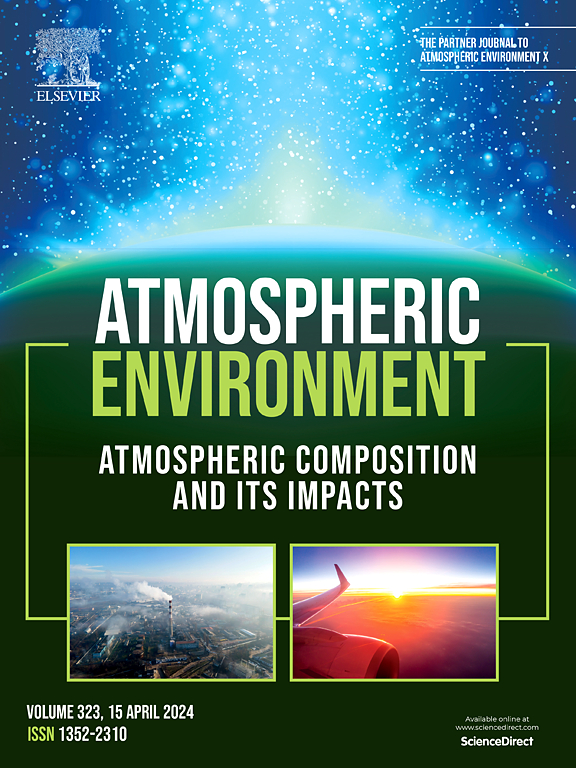Evaluation of black carbon emission inventories over Indian subcontinent: Role of open biomass burning and its representation in emission fluxes
IF 3.7
2区 环境科学与生态学
Q2 ENVIRONMENTAL SCIENCES
引用次数: 0
Abstract
Black carbon (BC) aerosols play an important role in air pollution, environment, and climate. Emission inventories of BC are key inputs for atmospheric models that assess the impact of BC emissions on health and the environment. However, estimated BC emission fluxes are highly uncertain. In this study, we evaluated three emission inventories — the Community Emission Data System (CEDS), the Evaluating the Climate and Air Quality Impacts of Short-Lived Pollutants (ECLIPSE) and Global Fire Emission Database (GFED) — using the Lagrangian dispersion model FLEXPART, along with BC observations from two locations in India viz. Ahmedabad (urban) and Gadanki (rural). The modeled BC concentrations using ECLIPSE and CEDS were comparable to each other; however, the modeled BC concentrations were underestimated by a factor of 2 using these emission inventories. The annual mean biases between model and observation (observation-model) are approximately 3 μg/m3 and 1 μg/m3 at Ahmedabad (urban) and Gadanki (rural), respectively. Adding the contribution of biomass-burning sources from the GFED inventory (less than 0.01 μg/m3) did not significantly improve the bias. Open biomass burning (OBB) emissions, resulting from large-scale burning of biomass in agricultural fields, forests, and wastelands, is the largest contributor to BC concentrations globally and are highly uncertain. To investigate the underestimation of BC by the model and the role of OBB emissions in this discrepancy, a novel rank-based statistical framework is developed. This framework integrates satellite-detected fire hotspots, FLEXPART model, and ground-based observations to evaluate relative contribution of OBB emissions to BC concentrations. We find that OBB emissions are not a significant source of BC concentrations over Ahmedabad (23.03°N, 72.55°E). In contrast, BC emissions from OBB are underestimated at Gadanki (13.48°N, 79.18°E). The framework used to evaluate cause-effect relation between OBB and BC can help constrain better the sources of BC. This framework can be readily extended globally to evaluate other sectors where emission activity data can be observed using satellites.

印度次大陆黑碳排放清单评价:开放式生物质燃烧的作用及其在排放通量中的代表
黑碳气溶胶在大气污染、环境和气候中起着重要作用。BC排放清单是评估BC排放对健康和环境影响的大气模型的关键输入。然而,估计的BC发射通量是高度不确定的。在本研究中,我们使用拉格朗日色散模型FLEXPART评估了三个排放清单——社区排放数据系统(CEDS)、短期污染物对气候和空气质量影响评估(ECLIPSE)和全球火灾排放数据库(GFED)——以及来自印度两个地点的BC观测数据,即艾哈迈达巴德(城市)和加丹基(农村)。使用ECLIPSE和CEDS模拟的BC浓度具有可比性;然而,使用这些排放清单,模拟的BC浓度被低估了2倍。在Ahmedabad(城市)和Gadanki(农村),模型与观测(观测-模型)之间的年平均偏差分别约为3 μg/m3和1 μg/m3。从GFED库存中加入生物质燃烧源的贡献(小于0.01 μg/m3)并没有显著改善偏差。开放式生物质燃烧(OBB)排放是由农田、森林和荒地大规模燃烧生物质造成的,是全球BC浓度的最大贡献者,具有高度不确定性。为了研究该模型对BC的低估以及OBB排放在这种差异中的作用,我们开发了一个新的基于排名的统计框架。该框架整合了卫星探测的火灾热点、FLEXPART模型和地面观测,以评估OBB排放对BC浓度的相对贡献。我们发现,在艾哈迈达巴德(23.03°N, 72.55°E), OBB排放不是BC浓度的重要来源。相比之下,Gadanki(13.48°N, 79.18°E) OBB的BC排放量被低估了。用框架来评价OBB和BC之间的因果关系,有助于更好地约束BC的来源。这一框架可以很容易地扩展到全球,以评估可以利用卫星观测排放活动数据的其他部门。
本文章由计算机程序翻译,如有差异,请以英文原文为准。
求助全文
约1分钟内获得全文
求助全文
来源期刊

Atmospheric Environment
环境科学-环境科学
CiteScore
9.40
自引率
8.00%
发文量
458
审稿时长
53 days
期刊介绍:
Atmospheric Environment has an open access mirror journal Atmospheric Environment: X, sharing the same aims and scope, editorial team, submission system and rigorous peer review.
Atmospheric Environment is the international journal for scientists in different disciplines related to atmospheric composition and its impacts. The journal publishes scientific articles with atmospheric relevance of emissions and depositions of gaseous and particulate compounds, chemical processes and physical effects in the atmosphere, as well as impacts of the changing atmospheric composition on human health, air quality, climate change, and ecosystems.
 求助内容:
求助内容: 应助结果提醒方式:
应助结果提醒方式:


